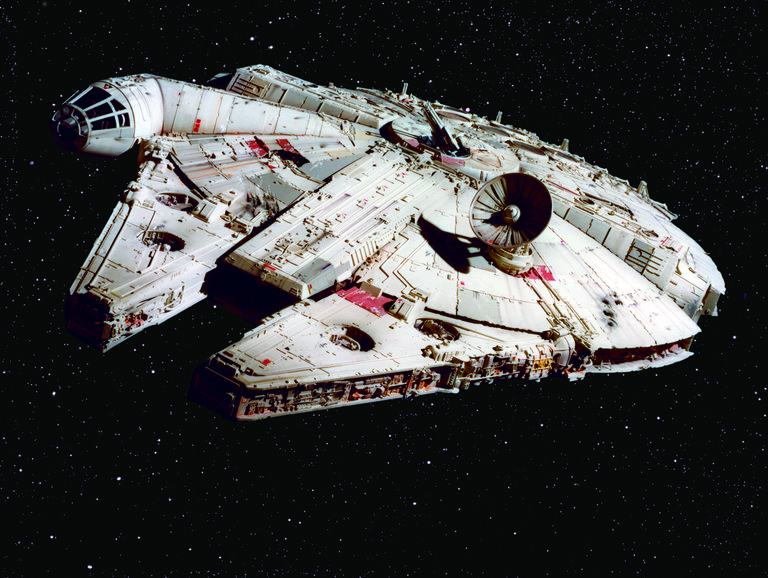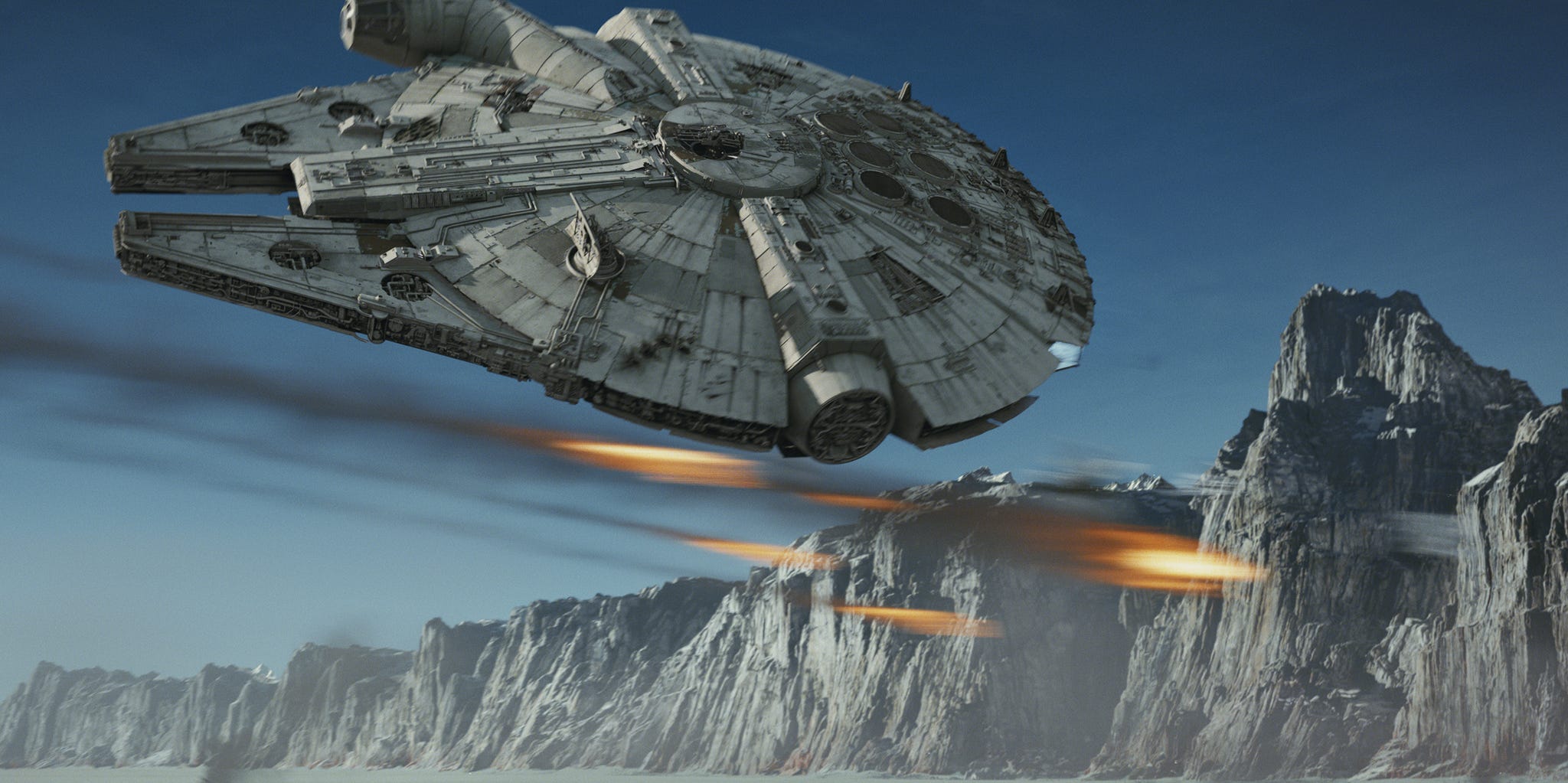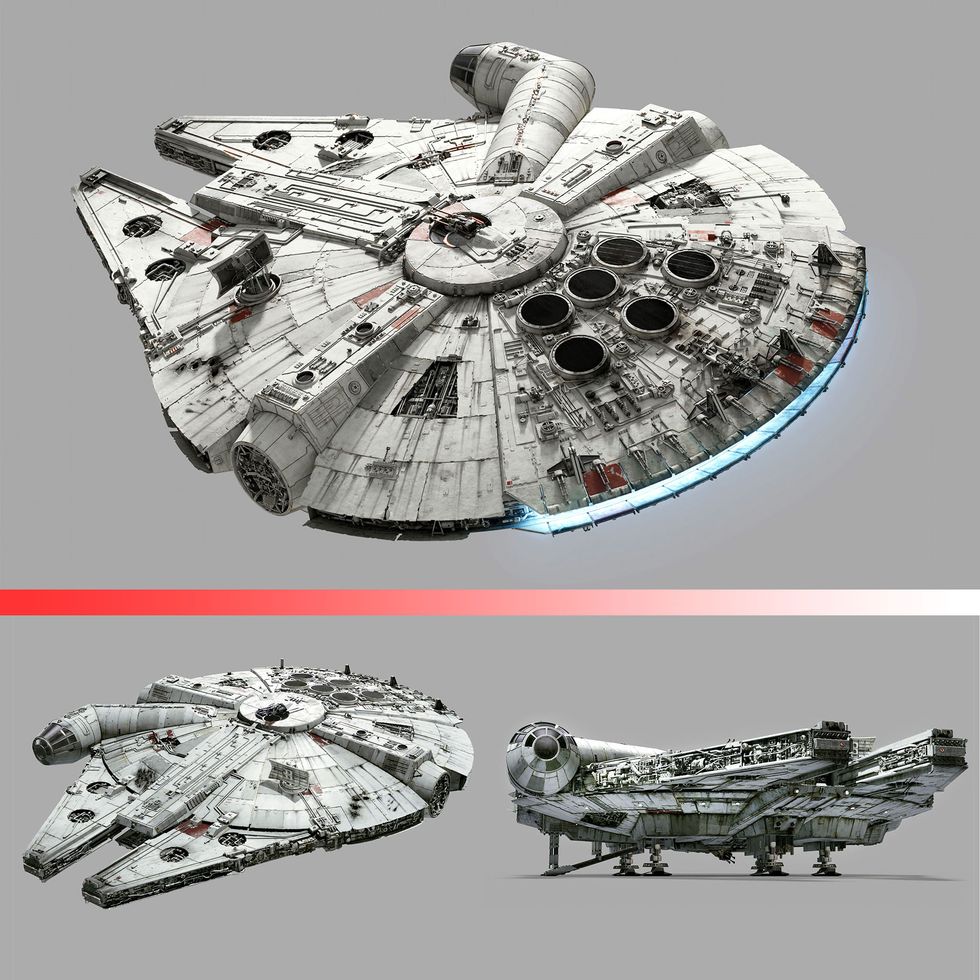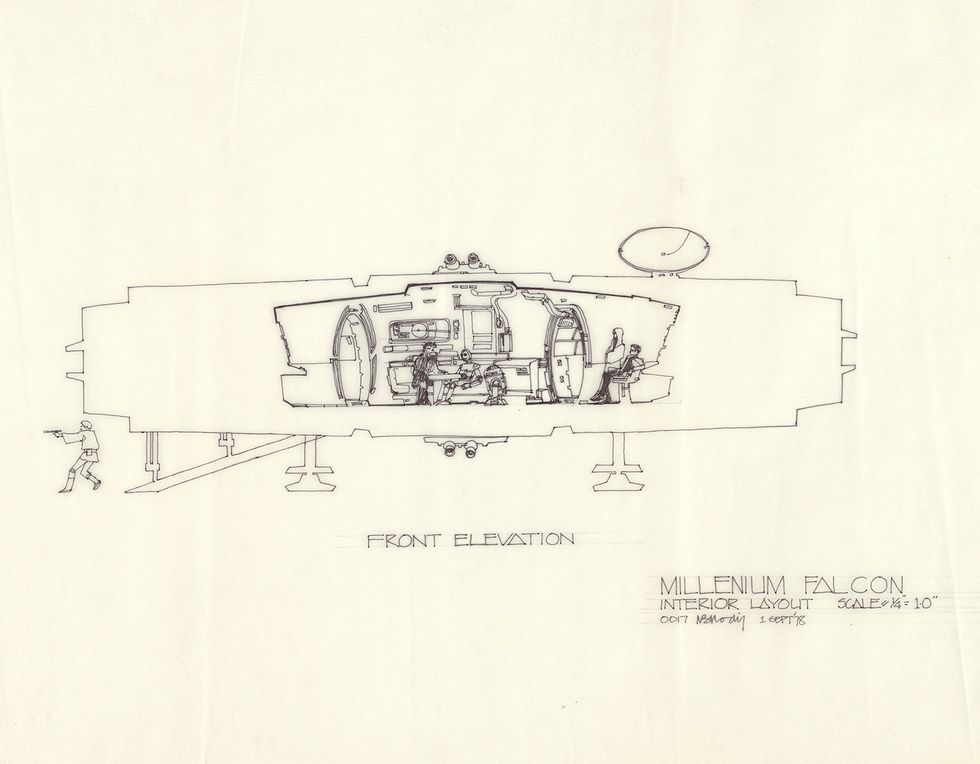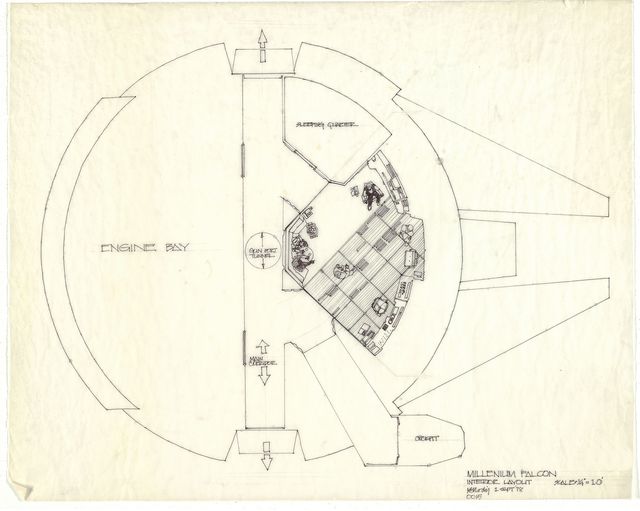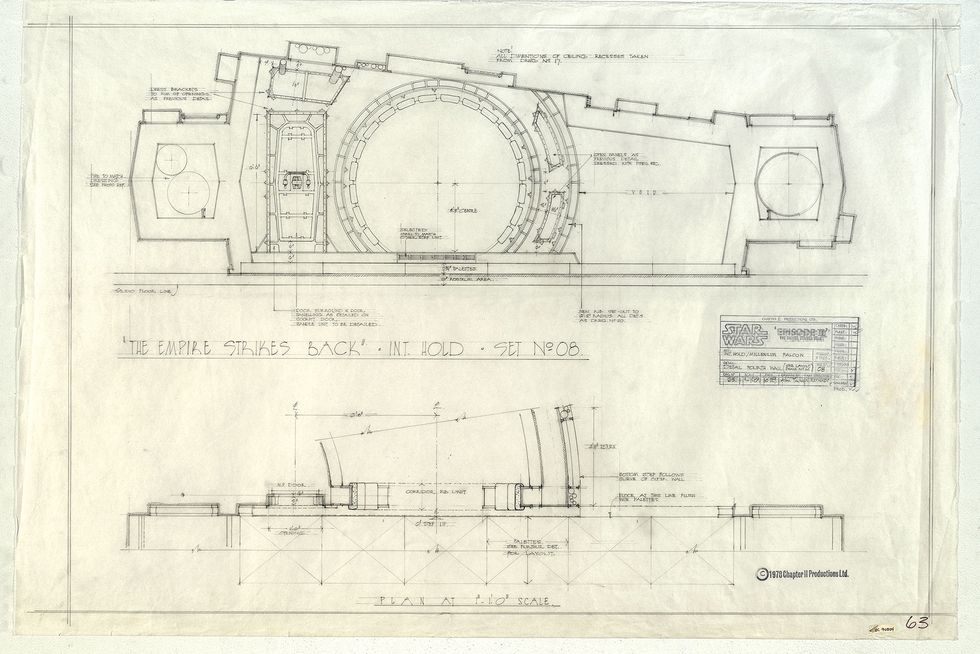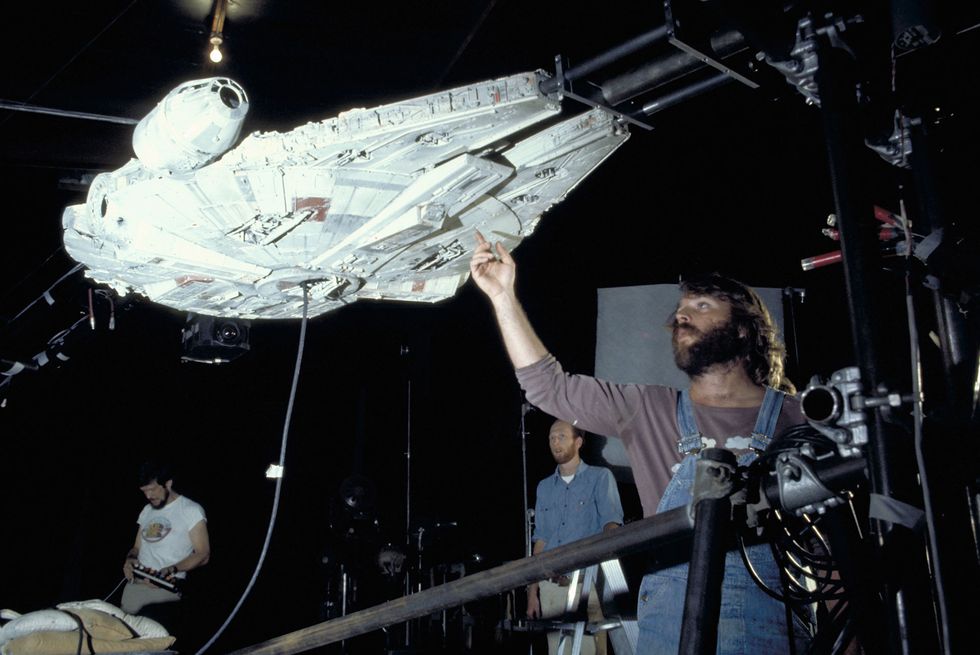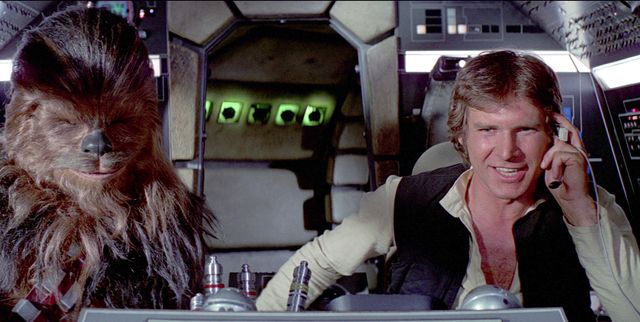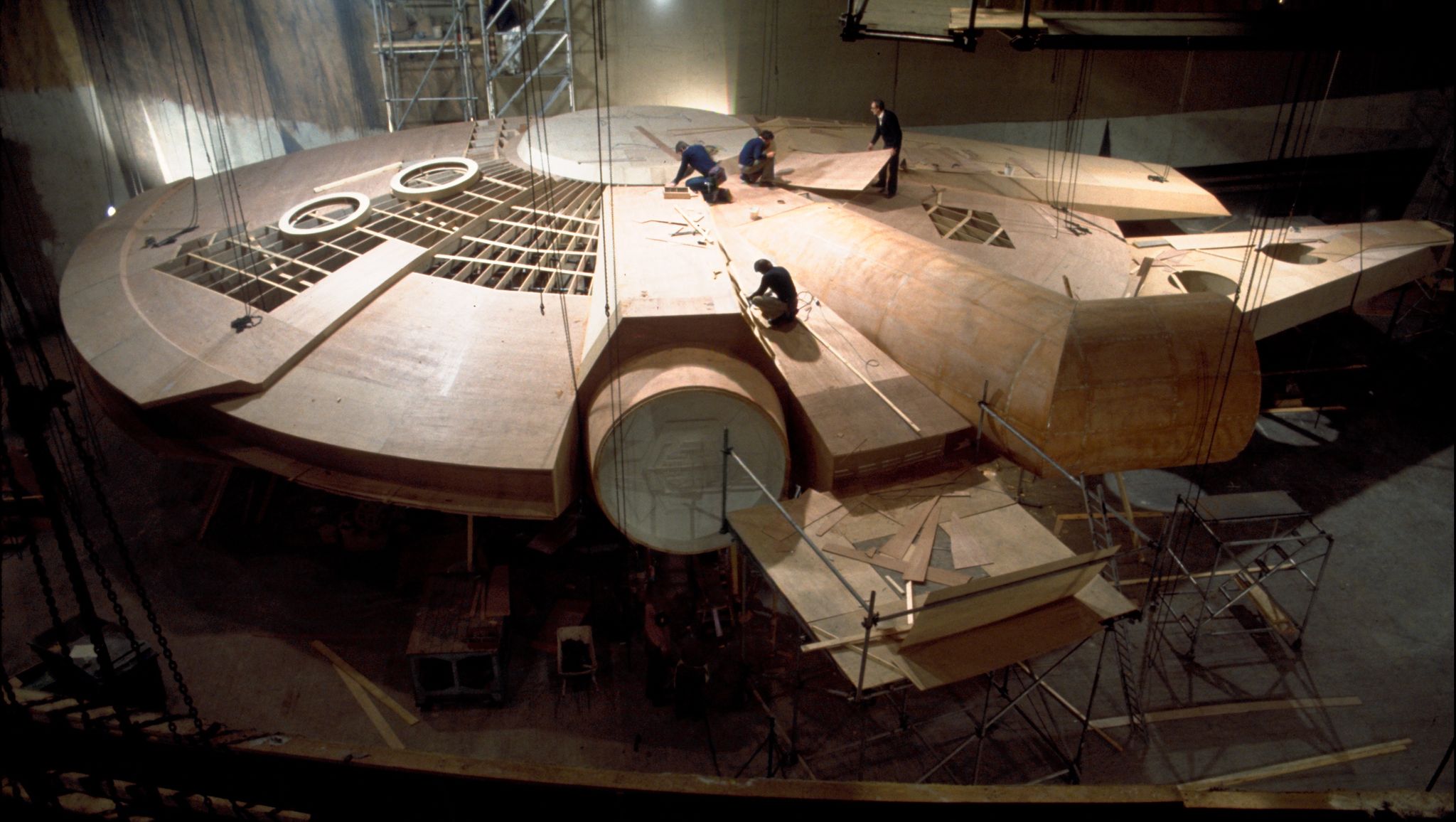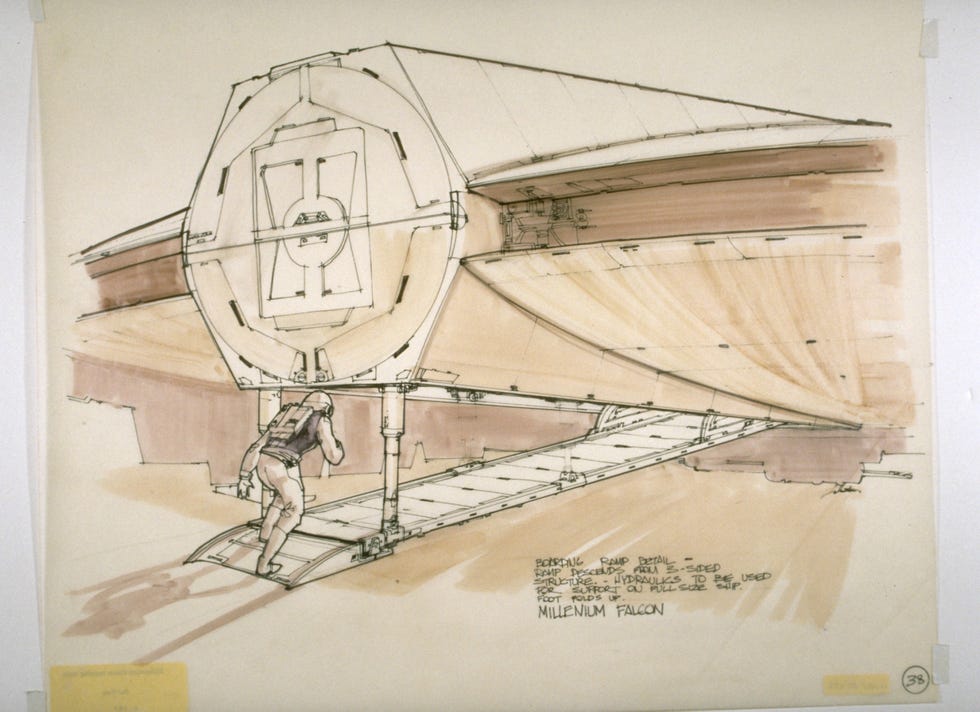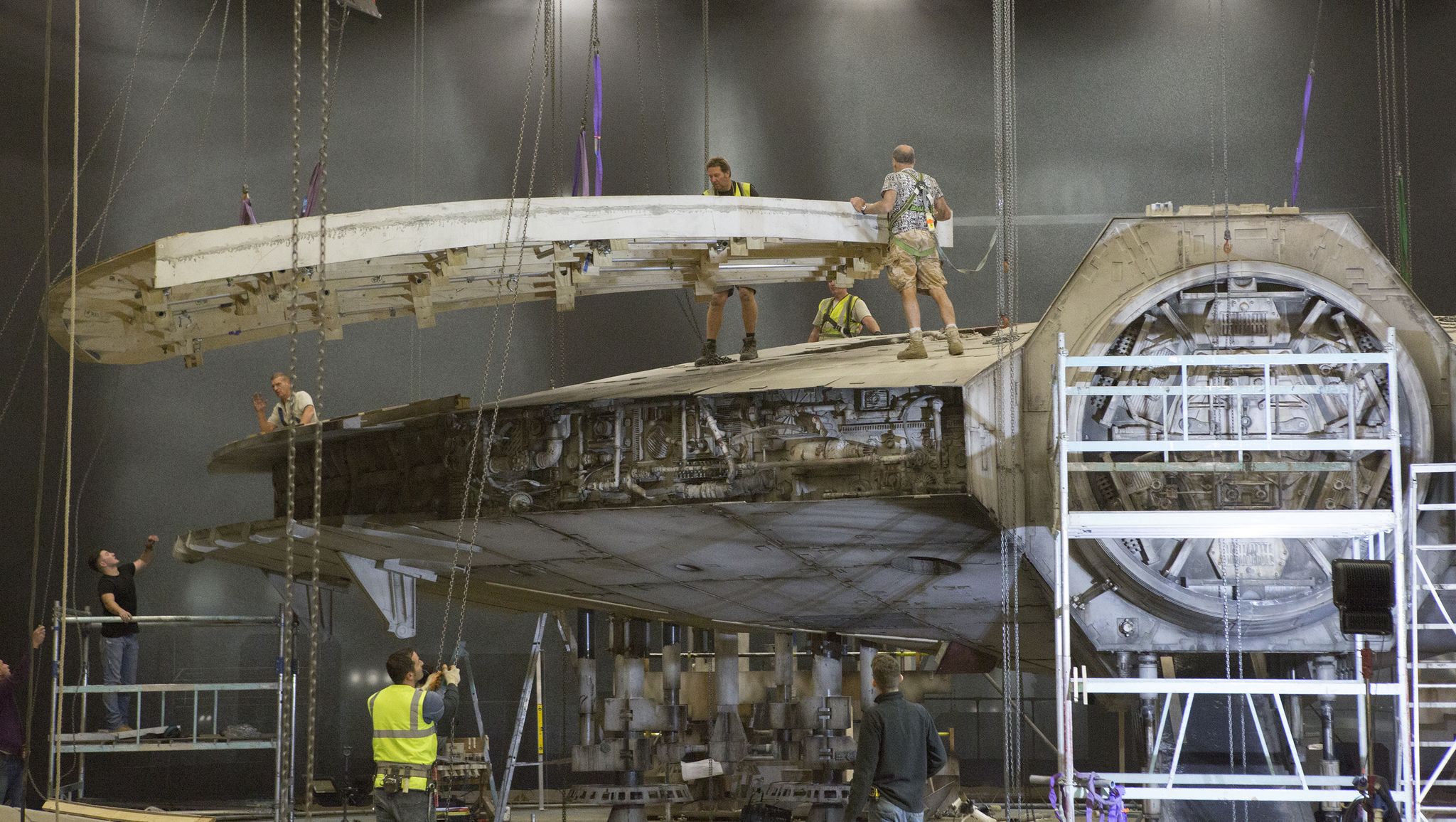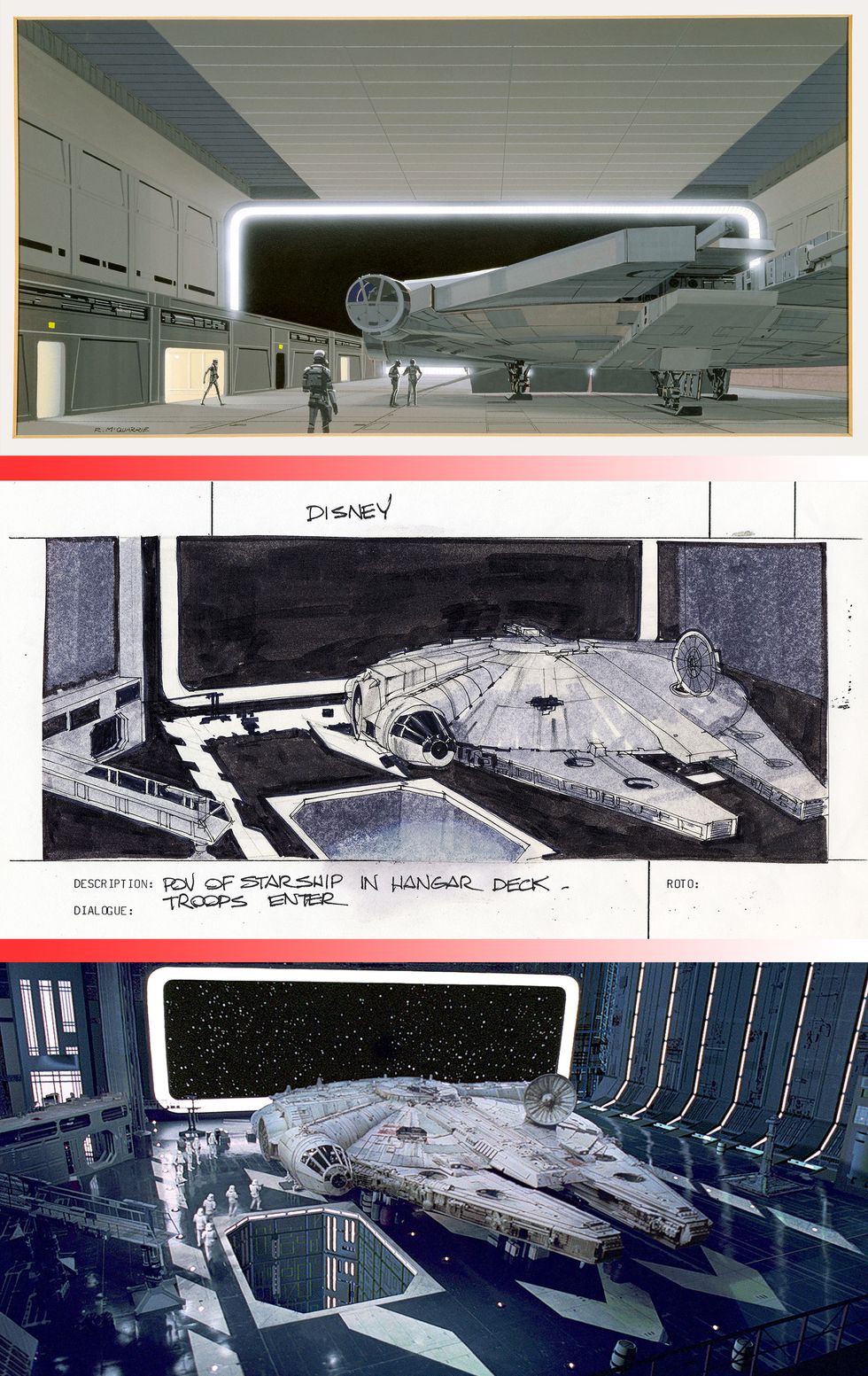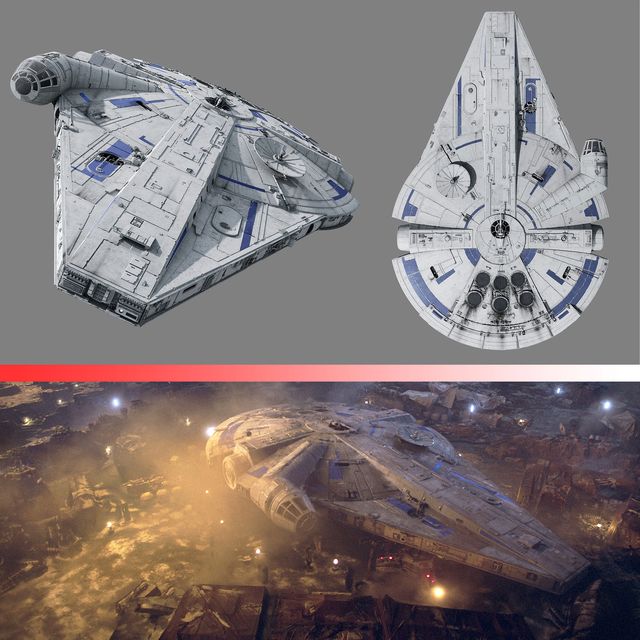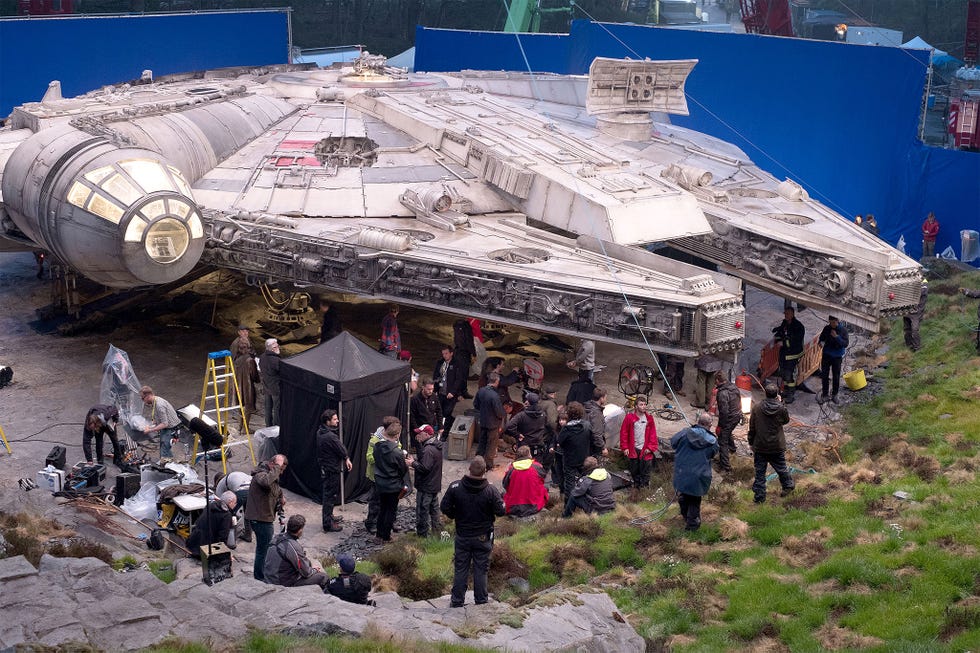The Millennium Falcon has always been defined by Luke Skywalker’s first impression of the YT-1300 freighter in 1977’s Star Wars: A New Hope: “What a piece of junk!” But more than 40 years later, Luke’s dismissive words have been adapted by Star Wars fans and filmmakers into a refrain of endearment. There are bigger, sleeker, more imposing vehicles in Star Wars, but on the eve of what might be its final flight in The Rise of Skywalker, the Millennium Falcon remains the most iconic ship from George Lucas’ galaxy far, far away.
“That was always George’s description of it: a piece of junk,” says Roger Christian, the Oscar-winning set decorator on the original Star Wars. “This wasn’t a smooth, beautiful ship.”
Maybe not, but to paraphrase its pilot, the Falcon has it where it counts. According to the authoritative Millennium Falcon “Owner’s Workshop Manual” published in 2011, a typical YT-1300 reaches a maximum speed of about 500 mph, but the Falcon has been clocked at 650 mph. With its Quadex power core, Isu-Sim SSP05 hyperdrive generator and dual Girodyne SRB42 sublight engines, it can outrun Imperial starships and, according to Han Solo, “make point-five past lightspeed.” About 113 feet long from the tip of its mandibles to its wide-bar engines, the Falcon is souped-up and battle-tested thanks to military-grade deflector shields, twin CEC AG-2G quad laser cannons, a pair of Arakyd ST2 concussion missile tubes, and a BlasTech Ax-108 blaster cannon. And for some reason, it has a radar dish.
When Christian and the rest of the Star Wars creative team were dreaming up the Falcon, they didn’t discuss specs. In the early days of Star Wars, Lucas and his colleagues were more concerned with design than mechanics. The movie’s tight production schedule meant the ship’s look took precedence. “Any science fiction film of this size would have nine months to a year’s worth of preparation,” Christian says. “We had two-and-a-half months.”
The first Falcon design seemed an ode to a classical starship, but Lucas wanted something more distinctive, says Christian. “George said, ‘Make it like a hamburger,’ which gave it a unique, flying-saucer element. That round shape was aerodynamic, and it had a kind of authenticity. It seemed like something that, if it jumped to hyperspeed, it wouldn’t get damaged."
The Falcon’s interior, meanwhile, emphasized the practical above the aesthetic, so Christian looked at the compact functionality of naval vessels, space shuttles, and race cars. “The interiors of submarines are practical—just pipes, tubes, and dials—and the original Apollo capsules were crammed,” he says. “In Formula 1, speed is equivalent to weight, not just the power of the engine, so they would strip everything out. I thought about the Falcon logically. Things have to work and be accessible. This is a utilitarian transport ship. Han didn’t buy a jetliner.”
Workaday as it may be, the Millennium Falcon’s non-traditional design posed some logical challenges for the builders. For one thing, the cockpit was on the side of the vessel—how would Han see anything to his left?—and the radar dish on top completely botched the aerodynamics. (“That’s probably the least practical part of the whole ship,” Christian admits of the dish, which was knocked off the Falcon during Return of the Jedi’s climactic battle.)
The Falcon’s cannons, too, carried a flaw that future Star Wars craftspeople would have to accept. As seen in A New Hope, a ladder in the middle of the Falcon leads to a pair of cannons, one at the top of the ship and one at the bottom. However, there doesn’t seem to be enough room for two gun pits and a ladder within the freighter, and the guns themselves don’t seem to have a range that matches their field of view. “It’s totally off,” says Jay Machado, senior hard surface modeler at Industrial Light & Magic, the company that supervised effects for the Star Wars films. “You can’t really see out of those pits. It’s one of those things where the visual storytelling was way more important than functionality.”
But those quirks made the Millennium Falcon beloved. It’s scruffy looking. Unlike modern sci-fi epics like Interstellar or The Martian, which hired physicists to ensure their science was sound, Star Wars never sweated the details. “Science simply doesn’t work in Star Wars,” says Kevin Jenkins, supervising art director on The Force Awakens and production designer for The Rise of Skywalker. “That’s why it’s called a space fantasy.”
Fantasy or not, the task of building the Falcon was real, and under a limited budget and a tight deadline, Christian scoured junkyards for materials. In South West England he came across eight unused cargo planes from the Royal Air Force and scavenged them, taking everything he thought might lend the Falcon a weathered, hand-me-down look. The freighter’s CEC AG-2G quad laser cannons were inspired by British WWII planes like the Lancaster, which had rear-facing turrets where gunners could swivel and fire at the enemy.
For the Falcon’s cockpit, Christian borrowed the ejector seats from a jet fighter and used a repurposed phone exchange, some 1970s calculators, and more plane parts to produce the various switches and levers for Han and Chewie, including the famous hyperdrive lever. When shooting began, Christian worked with Harrison Ford to make sure the actor wouldn’t break the fragile set. “I would say to him, ‘Harrison, I don’t know how long it’ll hold up.’ He’d always say, ‘Don’t worry, I’ll make it work.’ And he did.”
When the original Star Wars debuted in theaters, the Millennium Falcon was an instant hit on screen and in merchandising (the official Falcon toy cost $30 in 1979, and if you have one today in its original packaging, it could be worth as much as $450). But despite adoration from fans and critics, the ship didn’t survive the original trilogy—Jenkins says the first Falcon was trashed after The Empire Strikes Back. When the craft made its return for 2015’s The Force Awakens, the design team had to refer to set photos, blueprints, and scale models to piece it back together. What’s more, they had to make small changes to convey how 32 years had passed since the ship’s last appearance in Return of the Jedi.
“Because the Falcon’s so aged anyway,” Jenkins says, “It was hard to give any more history to what, essentially, looked like a dilapidated model kit.” The Force Awakens’ art team installed a few modifications to show how time had treated the ship—including an antenna to replace the ill-fated radar dish—but they stuck largely to the Falcon that appeared in The Empire Strikes Back, the most-documented version of the ship to that point.
Jenkins and the rest of the art team agonized over the minutiae of the craft, recreating details even the geekiest Star Wars fan wouldn’t notice. “There is a LEGO brick halfway up the ramp that was on the original ship,” Jenkins says. “We found the original place, and we put our LEGO brick there. Everything is recreated to a millimeter of what it was.”
But some things were improved. Jenkins says for The Force Awakens, Harrison Ford asked for springs in the toggle switches to make manning the cockpit more satisfying. “The [original] Millennium Falcon was essentially a giant model spaceship. The levers flopped, and he wanted the toggle switches to flick nicely back and forth.”
The only time the Falcon received major changes was for 2018’s Solo: A Star Wars Story, an origin story for Han and Chewie that explained how the smugglers acquired the ship from their debonair pal Lando Calrissian. In this movie, Star Wars art designers unveiled a retro Falcon, a sleeker, flashier model with gleaming white paint and an auxiliary escape pod between the two mandibles.
“I like the idea of Lando adding that piece,” Jay Machado says, “He wouldn’t want this ugly gaping mouth in the front. [With this design], it’s almost a big teardrop. It’s got style to it.” The streamlined look reflected Lando’s character, too, Machado says, similar to how the haphazard-yet-charming look suited Han.
In May 2019, Star Wars released a consumer model of sorts for the Millennium Falcon. The Star Wars: Galaxy’s Edge park, which opened in May at Disneyland and August at Walt Disney World, offers a comprehensive tour inside what has been billed as the definitive rendition of the ship. Asa Kalama, executive creative director for Walt Disney Imagineering, led his team in replicating the new trilogy’s model of the Falcon for fans. The designers scuffed it up for an authentic feel.
“That sense of dilapidation is something our fans expect and something we worked hard to capture,” Kalama says. “It’s what makes the Millennium Falcon feel like the Millennium Falcon. It’s the oil run coming off that pipe overhead. It’s the wear in the seats around the holographic chess table. All of those gritty, dirty details make it feel like Star Wars.”
Instead of scouring junkyards, Kalama’s team worked in reverse, adding character to mint-condition parts through paint and other cosmetics. A particular emphasis: the hyperspace lever. “We wanted to make sure all of the switchgear had a satisfying [tactile quality],” he says. “It was about making sure the hyperspace lever was friction-dampened so it had that heft you would expect, and a satisfying clunk at the end of the stroke that really made it feel like you were activating hyperspace. It took dozens upon dozens of prototypes to make you believe you are inside of a spaceship—not a toy—that’s capable of doing amazing things.”
That sense of underdog possibility has made the Millennium Falcon an icon. “I’ve loved it since I first saw it,” says Machado. “It’s the asymmetry of it. That’s a bold choice a lot of sci-fi designers don't go with. It's how grimy and dirty it is. It’s the charisma of Han Solo bragging about it. There's something about it that really resonates with me.”
And people love the Falcon because, well, it is a piece of junk. “If it always worked perfectly, it wouldn’t add any drama to the stories,” Kalama says. “The fact that you never quite know if it’s going to outrun that TIE fighter or make it out of that Star Destroyer hangar bay is part of what makes it so charming.”
The Rise of Skywalker might be the modified YT-1300’s swan song. For the filmmakers who helped bring the Falcon to life, it will be hard to say goodbye to the ship that embodied the swashbuckling spirit of its franchise. Kevin Jenkins struggles to summarize the immensity of the Falcon’s legacy. “It’s hard to describe as someone who’s spent a lot of time inside it and also spent a lot of time looking at it as a kid in the movies,” he admits. Then he laughs. “Don’t get me wrong: The first time you stand on that set, it’s awesome. It’s like nothing else...You’re a 10-year-old again.”


